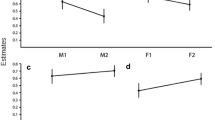Summary
Tadpoles of Rana temporaria which have been raised in an artificial pond prey in the experimental situation shown in Fig. 1 upon the spawn of the following sympatric European Anura species: Rana temporaria (cannibalism), Rana esculenta, Rana ridibunda, Bufo bufo, Bufo calamita, Bombina variegata and Hyla arborea (predation). — Rana temporaria is an early breeder. Thus selection pressure acts in the following ways: Rana temporaria establishes for itself an explosive breeding pattern. Species which breed later in the year in shallow water are suppressed in the biotope of Rana temporaria and develop other biotope preferences (Bombina variegata, Bufo calamita, Hyla arborea). Rana esculenta, Rana ridibunda and Bufo bufo spawn in deeper water. Therefore they are scarcely exposed to the tadpoles of Rana temporaria. Moreover Bufo bufo, too, is an early breeder. Alytes obstetricans laying no spawn in the water is not endangered. — An analysis of biotope preferences and breeding times of the species involved confirms these interpretations.
Zusammenfassung
In einem Kunstweiher aufgezogene Kaulquappen von Rana temporaria fressen in der Versuchsanordnung von Abb. I den Laich folgender sympatrischer Anuren-Arten: Rana temporaria (Kannibalismus), Rana esculenta, Rana ridibunda, Bufo bufo, Bufo calamita, Bombina variegata und Hyla arborea (Laichräubern). — Daß die Kaulquappen der früh im Jahr laichenden Rana temporaria später gelegten arteigenen und artfremden Laich fressen, wirkt als Selektionsdruck in folgende Richtungen: Rana temporaria züchtet sich selbst eine kurze Laichzeit. Spät in seichtem Wasser laichende Arten werden im Biotop von Rana temporaria unterdrückt (Bombina variegata, Bufo calamita, Hyla arborea). Rana esculenta, Rana ridibunda und Bufo bufo sind dem Laichräubern durch Kaulquappen wenig ausgesetzt, weil sie in größeren Wassertiefen laichen. Zudem ist Bufo bufo ebenfalls ein Frühlaicher. Alytes obstetricans steht außer Konkurrenz, weil er die Eier nicht ins Wasser setzt. — Untersuchungen über die Biotoppräferenzen und Laichzeiten der betroffenen Arten bestätigen diese Interpretation.
Similar content being viewed by others
Literatur
Bragg, A. N.: Dimorphism and cannibalism in tadpoles of Scaphiopus bombifrons (Amphibia, Salientia). Southwestern Nat. 1, 105–108 (1956).
—: Predator-prey relationship in two species of spadefoot tadpoles with notes on some other features of their behavior. Wasmann J. Biol. 20, 81–97 (1962).
—: Further study of predation and cannibalism in spadefoot tadpoles. Herpetologica 20, 17–24 (1964).
Escher, K., Heusser, H., Meisterhans, K.: Bestandsaufnahme der Amphibien im Kanton Zürich. (In Vorbereitung.)
Heusser, H.: Die Lebensweise der Erdkröte, Bufo bufo (L.); Wanderungen und Sommerquartiere. Rev. suisse Zool. 75, 927–982 (1968).
Heusser, H.: Ethologische Bedingungen für das Vorkommen von Territorialität bei Anuren. (Im Druck.)
— Ott, J.: Wandertrieb und populationsspezifische Sollzeit der Laichenwanderung bei der Erdkröte, Bufo bufo (L.). Rev. suisse Zool. 75, 1005–1022 (1968).
Savage, R. M.: The ecology and life history of the common frog (Rana temporaria) 221 p., London: Pitman 1961.
—: A speculation on the pallid tadpoles of Xenopus laevis. Brit. J. Herpetol. 3, 74–76 (1963)
Witschi, E.: Die Entwicklung der Keimzellen der Rana temporaria L. I. Urkeimzellen und Spermatogenese. Z. Zellen- und Gewebelehre (Abt. B. Z. wiss. Biol.) 1, 523–561 (1924).
Author information
Authors and Affiliations
Additional information
Mit Unterstützung des Schweizerischen Nationalfonds zur Förderung der wissenschaftlichen Forschung.
Rights and permissions
About this article
Cite this article
Heusser, H. Laich-Fressen durch Kaulquappen als mögliche Ursache spezifischer Biotoppräferenzen und kurzer Laichzeiten bei europäischen Froschlurchen (Amphibia, Anura). Oecologia 4, 83–88 (1970). https://doi.org/10.1007/BF00390615
Issue Date:
DOI: https://doi.org/10.1007/BF00390615




